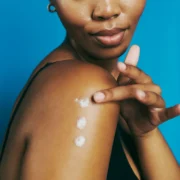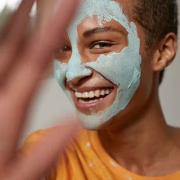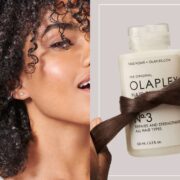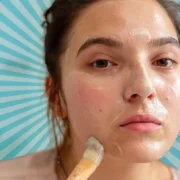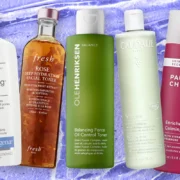Loofahs, commonly known as bath sponges, are a popular bathing accessory used for cleansing and exfoliating the skin. They are made from the fibrous material of the loofah plant, which is a type of gourd. There are two main types of loofahs: natural and synthetic.
Natural loofahs are made from the dried fibrous interior of the loofah plant and offer a more natural and sustainable option. Synthetic loofahs, on the other hand, are typically made from plastic or synthetic materials and offer a longer lifespan.
Using a loofah has several benefits for the skin. One of the main advantages is its exfoliating properties, which help remove dead skin cells and promote smoother, healthier skin. The use of a loofah can improve blood circulation, stimulate lymphatic drainage, and enhance skin texture.
When using a loofah, it is important to follow proper usage techniques. This includes wetting and softening the loofah before use, applying gentle pressure during exfoliation, and cleaning and drying the loofah after each use to prevent bacterial growth.
There are some common misconceptions about loofahs, such as the idea that they harbor bacteria or cause skin irritation. However, with proper care and cleaning, these concerns can be minimized.
In addition to loofahs, there are alternative bathing accessories available that offer similar benefits. These include bath brushes, bath sponges, and exfoliating gloves.
What is a Loofah?
A loofah, also known as a shower sponge, is a natural exfoliating tool made from the fibrous material derived from the fruit of the loofah plant. This remarkable tool is widely utilized in skincare routines due to its ability to effectively remove dead skin cells and promote circulation.
The unique texture of the loofah allows for deep cleansing, helping to unclog pores and leaving the skin feeling remarkably smooth and refreshed. Whether you use it during your shower or bath routine, you can enjoy the invigorating sensation it provides.
However, the benefits of a loofah extend beyond personal care. It can also be employed for various household cleaning purposes, making it a versatile tool to have around the house.
Interestingly, the history of loofah usage dates back to ancient times. There is evidence of loofahs being utilized in bathing practices in ancient Egypt and Greece, highlighting their longstanding importance in personal hygiene.
Types of Loofahs
When it comes to loofahs, there’s more than meets the eye! Get ready to dive into the world of different types of loofahs. From natural loofahs to synthetic ones, we’ll explore the unique characteristics and benefits of each. So buckle up and let’s scrub away the confusion as we dive into the wonderful world of loofahs!
Natural Loofahs
- Natural loofahs are a product derived from the fibrous skeleton of a fruit known as the Luffa cylindrical.
- These natural loofahs are both biodegradable and environmentally friendly.
- Their rough texture allows for excellent exfoliation of the skin.
- It is possible to use natural loofahs with or without soap in order to eliminate dirt, dead skin cells, and impurities.
- Additionally, they aid in the improvement of blood circulation by stimulating the skin.
- Gentle enough for daily use, regular replacement of natural loofahs is recommended to prevent bacterial growth.
Fun fact: Did you know that natural loofahs can also serve as natural dish scrubbers? Their abrasive texture makes them ideal for eliminating stubborn food stains and grease from pots and pans!
Synthetic Loofahs
Synthetic loofahs have become increasingly popular as a substitute for natural loofahs due to their exceptional durability and extended lifespan. It is important to take into account the following key factors regarding synthetic loofahs:
For more information on loofa, please visit the loofa Wikipedia page.
- Hygienic: Unlike natural loofahs, synthetic loofahs are resistant to bacteria and mold growth, making them a far more hygienic choice.
- Softness: One of their notable advantages is that synthetic loofahs are generally softer and more gentle on the skin, rendering them perfect for individuals with sensitive skin types.
- Eco-friendly: Certain synthetic loofahs are manufactured using recycled materials, contributing to waste reduction and minimizing their environmental impact.
- Longevity: Due to their reduced susceptibility to wear and tear, synthetic loofahs outlast natural loofahs, thereby extending their lifespan.
The development of synthetic loofahs was a direct response to the growing demand for a more enduring and sanitary alternative to natural loofahs. Their increased longevity and hygienic qualities have revolutionized the way people exfoliate and care for their skin.
Benefits of Using a Loofah
Looking to take your skincare routine to the next level? Let’s dive into the amazing benefits of using a loofah! From exfoliation to improved blood circulation and removal of dead skin cells, these sub-sections have got it covered. Get ready to discover the secrets of getting smooth, radiant skin with the power of a loofah. No more dullness or rough patches – embrace the rejuvenating benefits that await you! So, let’s explore how this simple tool can revolutionize your skincare routine.
Exfoliation
Exfoliation is a crucial step in skincare that aids in the removal of dead skin cells, revealing smoother, brighter skin. Here are some natural steps to effectively exfoliate with a loofah:
-
Initiate with moist skin: Wet your body or face with warm water to gently soften the skin.
-
Apply a mild cleanser: Put a gentle exfoliating cleanser onto the loofah or directly onto your body or face.
-
Delicately scrub in circular motions: Employ the loofah in circular motions, applying slight pressure to exfoliate the skin tenderly.
-
Concentrate on problematic areas: Give extra attention to rougher or dry patch-prone areas such as elbows, knees, and heels.
-
Rinse off and hydrate: Rinse off the exfoliated skin with warm water and follow up with a moisturizer to add hydration and soothe the skin.
Keep in mind, exfoliation should be conducted once or twice a week, depending on your skin type. If you have sensitive skin, choose a softer loofah or explore alternative exfoliation methods like chemical exfoliants or gentle scrubs. Enjoy the benefits of a smoother and more radiant complexion!
Improved Blood Circulation
Improving blood circulation with a loofah during bathing
- Increased blood flow: Using a loofah for gentle scrubbing stimulates blood vessels near the skin’s surface, promoting improved blood circulation.
- Reduces swelling: The enhanced circulation helps decrease body swelling, aiding in the healing process and reducing discomfort.
- Boosts skin health: By ensuring efficient delivery of nutrients and oxygen to skin cells, proper blood circulation from using a loofah enhances complexion and promotes healthier skin.
Fact: Did you know that regular exercise and staying hydrated are also effective ways to improve blood circulation?
Removal of Dead Skin Cells
The Removal of Dead Skin Cells is a crucial benefit of utilizing a loofah. To effectively eliminate dead skin cells, adhere to these steps:
- Wet your skin with warm water.
- Apply a small amount of mild soap or body wash to the loofah.
- Gently scrub your skin using circular motions.
- Pay extra attention to areas prone to roughness, like elbows and knees.
- Rinse your body thoroughly to remove any soap residue.
- Pat your skin dry with a towel.
Pro-tip: Exfoliate your skin with a loofah 2-3 times a week to maintain smooth, healthy-looking skin.
How to Properly Use a Loofah
- Using a loofah properly can help exfoliate your skin and leave it feeling smooth and refreshed. Here are some steps to follow when using a loofah:
- Wet the loofah with warm water to soften it.
- Apply a small amount of body wash or soap onto the loofah.
- Gently scrub your body in circular motions, starting from your feet and working your way up.
- Pay special attention to rough areas like your elbows, knees, and heels.
- Rinse off the soap and excess dead skin cells with warm water.
- Hang the loofah to air dry in a well-ventilated area.
Fact: Using a loofah regularly can help increase blood circulation and promote healthier-looking skin.
Common Misconceptions about Loofahs
Did you know that loofahs are often associated with harboring bacteria and causing skin irritation? In this section, we’ll uncover the truth behind these myths and shed light on the real story behind loofahs. Prepare to be surprised as we explore the facts and debunk some of the long-standing misconceptions surrounding these exfoliating bath tools. Get ready for a fresh perspective and a deeper understanding of loofahs!
Loofahs Harbor Bacteria
Loofahs harbor bacteria if not properly cared for. Here are some important considerations to avoid bacterial growth on your loofah:
- Clean and rinse your loofah thoroughly after each use to remove any residual soap or product.
- Allow your loofah to air dry completely in a well-ventilated area to prevent dampness, which can promote bacterial growth.
- Replace your loofah regularly, ideally every 3-4 weeks, to prevent the accumulation of bacteria.
- Consider using antimicrobial loofahs that are specifically designed to inhibit bacterial growth.
- Avoid sharing your loofah with others to minimize the risk of cross-contamination.
By following these practices, you can ensure that your loofah remains clean and free from harmful bacteria.
Loofahs Cause Skin Irritation
Loofahs, when not used properly, can potentially cause skin irritation. Here is a breakdown of the causes and preventive measures to avoid this issue:
| Causes of Skin Irritation | Preventive Measures |
|---|---|
| Rough Texture: Loofahs with coarse fibers can be too harsh on the skin, causing irritation. | Opt for loofahs with softer fibers or use a washcloth as an alternative. |
| Excessive Scrubbing: Over-scrubbing can strip away natural oils and disrupt the skin’s barrier, leading to irritation. | Gently scrub using circular motions and avoid applying too much pressure. |
| Improper Cleaning: Loofahs can collect bacteria, mold, and dead skin cells, leading to skin infections and irritation. | Clean and replace loofahs regularly to maintain hygiene. Allow them to dry completely after each use. |
| Allergic Reactions: Some people may have allergic reactions to the material or detergent used to clean the loofah. | Switch to a different material or opt for fragrance-free and hypoallergenic detergents. |
By following these preventive measures, you can minimize the risk of skin irritation and enjoy the exfoliating benefits of using a loofah.
Alternatives to Loofahs
If you’re looking for alternatives to loofahs, there are several options available that can give you a similar exfoliating experience:
- Body Scrub: Use a body scrub made of natural ingredients like sugar or salt.
- Bath Brush: Opt for a bath brush with soft bristles to gently exfoliate your skin.
- Exfoliating Gloves: These gloves are designed to effectively remove dead skin cells.
- Pumice Stone: Use a pumice stone to remove rough, dry skin from your feet.
- Konjac Sponge: Made from the konjac root, these sponges are gentle and perfect for sensitive skin.
Frequently Asked Questions
What is the Egyptian Arabic name for loofah?
The Egyptian Arabic name for loofah is “luffa aegyptiaca”.
What is Chinese okra?
Chinese okra is a common name for the species Luffa acutangula, which belongs to the cucumber family and is cultivated and eaten as a vegetable.
Is loofah suitable for men’s fashion?
Loofah is not typically used in men’s fashion. It is primarily known for its use as a natural body scrubber in shower routines.
What is the young stage of development of a loofah fruit?
The young stage of development for a loofah fruit is when it is still green and growing on the vine, before it ripens and turns brown.
Can I watch Prime Video while using a loofah?
Yes, you can watch Prime Video or engage in any other activity while using a loofah. It is a versatile accessory for shower routines.
Where is loofah commonly found in North America?
Loofahs can be found in North America, where they are grown in certain climates or sourced from other regions for use as natural alternatives to synthetic nylon scrubbers.

